The Best Ultimate Guide to Cultural Holidays in Morocco
Morocco isn’t just a destination—it’s a journey through time, tradition, and artistry. From the ancient alleyways of imperial cities to the hands of master artisans crafting centuries-old designs, the cultural richness of Morocco is unlike anywhere else on Earth. Whether you’re wandering through colorful souks, admiring Islamic architecture, or taking part in traditional festivals, a cultural holiday in Morocco offers an immersive experience for the curious traveler.
Why Morocco is a Cultural Goldmine
Strategically nestled between Europe and Africa, and bordered by the Mediterranean Sea and Atlantic Ocean, Morocco has long been a melting pot of civilizations. The Berbers, Arabs, Andalusians, French, and Spanish have all contributed to its vibrant cultural tapestry. This fusion is evident in every corner—from language and cuisine to architecture and religion.
In Morocco, culture isn’t confined to museums. It’s alive in the bustling medinas, vibrant festivals, ancient customs, and the daily rhythm of life.
Historic Cities: Fes, Marrakech, Meknes
Fes: The Intellectual Capital of Morocco
Fes is a living museum of Moroccan heritage and a cornerstone of the country’s intellectual and spiritual identity. Known as the oldest of Morocco’s imperial cities, Fes boasts a deep-rooted history that dates back over a millennium. At its heart lies Fes el-Bali, the walled medina that has earned UNESCO World Heritage status for its outstanding universal value. This labyrinthine city within a city is home to over 9,000 narrow alleyways, each leading to hidden gems like traditional workshops, ancient madrasas, and vibrant souks teeming with hand-crafted goods.
One of the city’s most treasured sites is the University of Al Quaraouiyine, established in 859 AD. Recognized by UNESCO and the Guinness World Records as the oldest existing and continually operating educational institution in the world, this university symbolizes Morocco’s long-standing dedication to knowledge and culture. Nearby, the Bou Inania Madrasa showcases the splendor of Marinid architecture, with intricate stucco, carved wood, and zellij tilework that reflects centuries of Islamic artistry.
Fes is also famous for its Chouara Tannery, where leather has been dyed and treated using ancient techniques for over 1,000 years. From a panoramic terrace above the tannery, visitors can watch artisans at work in stone vats filled with natural dyes—a striking scene that has remained largely unchanged since medieval times. Fes is not just a city; it’s a fully immersive cultural journey.
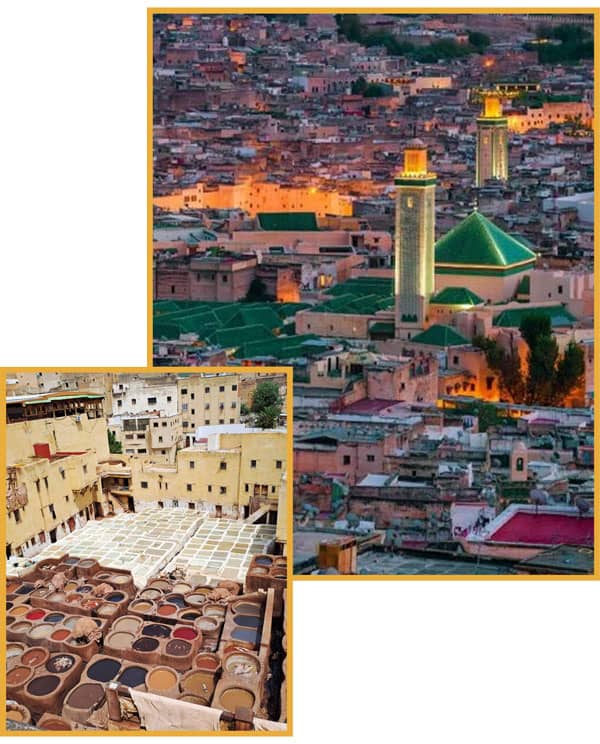
Marrakech: The Red City of Stories and Sensations
Few places ignite the imagination like Marrakech, Morocco’s famed “Red City.” With its vibrant energy, terracotta-colored walls, and a heady blend of sights, sounds, and smells, Marrakech is a city that embodies the Moroccan spirit. It stands as a fascinating intersection of history and modernity, where centuries-old traditions coexist with contemporary art, boutique riads, and international festivals.
At the core of Marrakech’s cultural identity lies Jemaa el-Fnaa, the bustling central square that transforms into an open-air theater every evening. Recognized as a UNESCO Intangible Cultural Heritage site, the square hosts everything from snake charmers and storytellers to street musicians and food vendors, offering an unforgettable spectacle of Moroccan folklore.
Not far from the square, the Bahia Palace serves as a breathtaking example of 19th-century Moroccan architecture. With its mosaic floors, intricate wood carvings, and lush courtyards, the palace was built to be the epitome of elegance and Moroccan craftsmanship. Marrakech also houses the Saadian Tombs, a royal necropolis rediscovered in 1917 that dates back to the late 16th century. These tombs are adorned with Italian Carrara marble and exquisite stucco work, making them one of the most visually stunning historic sites in the city.
The Koutoubia Mosque, Marrakech’s largest and most iconic mosque, stands as a spiritual and architectural anchor. Its 77-meter minaret can be seen from nearly every part of the medina, acting as both a place of worship and a symbol of the city’s Islamic heritage. From ancient medersas to modern art galleries, Marrakech is a dynamic cultural hub that continues to inspire.
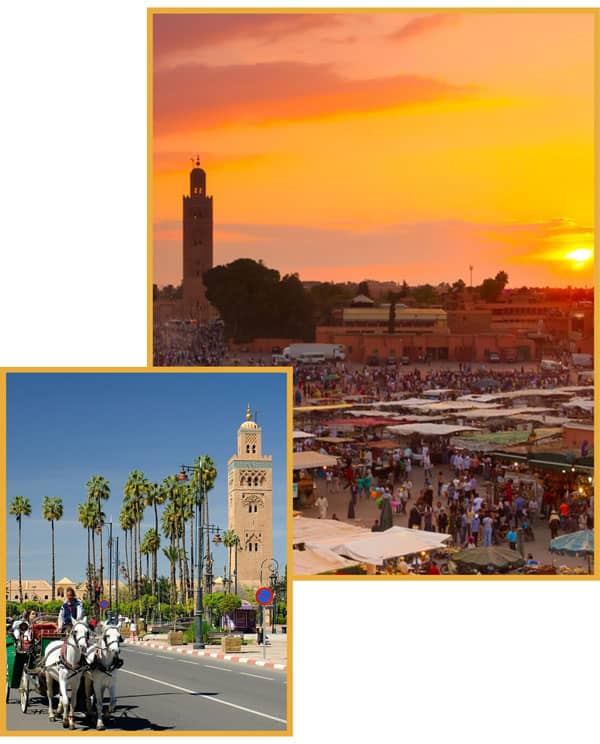
Meknes: The Underrated Gem of Imperial Morocco
Often overshadowed by its more famous imperial siblings, Meknes is a hidden treasure for travelers seeking authentic culture without the crowds. This serene and historically rich city was once the capital of Morocco under Sultan Moulay Ismail in the 17th century. His vision transformed Meknes into a grand imperial city, filled with architectural wonders and monumental structures that still command admiration today.
One of the city’s most striking landmarks is Bab Mansour, a monumental gate considered one of the finest in North Africa. Its towering archway, decorated with zellij mosaics and marble columns, is a masterpiece of Islamic design and a testament to Moroccan artistic excellence. Walking through this gate feels like stepping back into a regal past.
Another highlight of Meknes is the Royal Stables and Heri es-Souani Granaries, built to house and feed up to 12,000 royal horses. These colossal vaulted chambers are an engineering marvel, designed with advanced ventilation systems and irrigation to keep the animals and their food in optimal condition. The sheer scale and ambition of this structure speak volumes about the wealth and vision of the Alaouite dynasty.
At the heart of Meknes lies El Hedim Square, a lively plaza that echoes the ambiance of Jemaa el-Fnaa but with a quieter, more relaxed atmosphere. Surrounded by traditional souks, cafés, and the Dar Jamai Museum—an elegant 19th-century palace showcasing Moroccan arts and crafts—El Hedim is a cultural gathering spot where the essence of Meknes truly comes alive. For those wanting a deep dive into Moroccan culture without the hustle of larger cities, Meknes is the perfect escape.
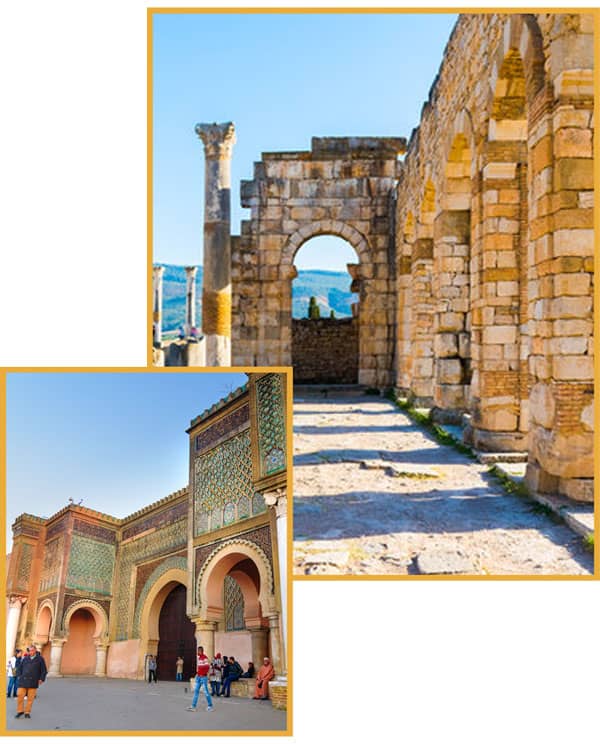
Rabat: The Elegant Capital of Culture
Often overshadowed by Morocco’s more touristy cities, Rabat is a refined blend of history, modernity, and political significance. As the administrative capital of Morocco and a UNESCO World Heritage Site, Rabat offers cultural travelers a quieter, more sophisticated experience, less crowded but equally rich in heritage.
Begin your journey at the Kasbah of the Udayas, a peaceful cliffside fortress with narrow white-and-blue lanes, bougainvillea-covered homes, and sweeping views of the Atlantic Ocean. This 12th-century stronghold is not only a scenic gem but also a place to witness daily Moroccan life in a serene setting. Within its walls, you’ll find the Andalusian Gardens, a tranquil oasis filled with orange trees, fountains, and birdsong—perfect for a midday pause.
The city’s most iconic landmark is the Hassan Tower, an unfinished 12th-century minaret intended to be the tallest in the world. Just across from it stands the Mausoleum of Mohammed V, a masterpiece of traditional Moroccan architecture with exquisite zellij tilework, white marble, and a green-tiled roof. This resting place of Morocco’s beloved monarchs is both spiritually significant and artistically impressive.
Rabat also hosts a thriving arts scene. Explore the Mohammed VI Museum of Modern and Contemporary Art, which showcases both Moroccan and international artists in a sleek, modern space. The city’s cultural calendar is equally dynamic, with events like the Mawazine Festival, one of Africa’s largest music festivals, attracting performers and visitors from across the globe.
For a taste of local life, head to Rue des Consuls in the medina, a historic street known for its artisan workshops. Here, you can watch craftsmen making leather goods, carpets, and silver jewelry, or simply sip mint tea while the world goes by.
Rabat may be the political heart of Morocco, but it is also its cultural conscience, a city where past and present harmoniously coexist, offering travelers both elegance and authenticity without the chaos of larger tourist hubs.
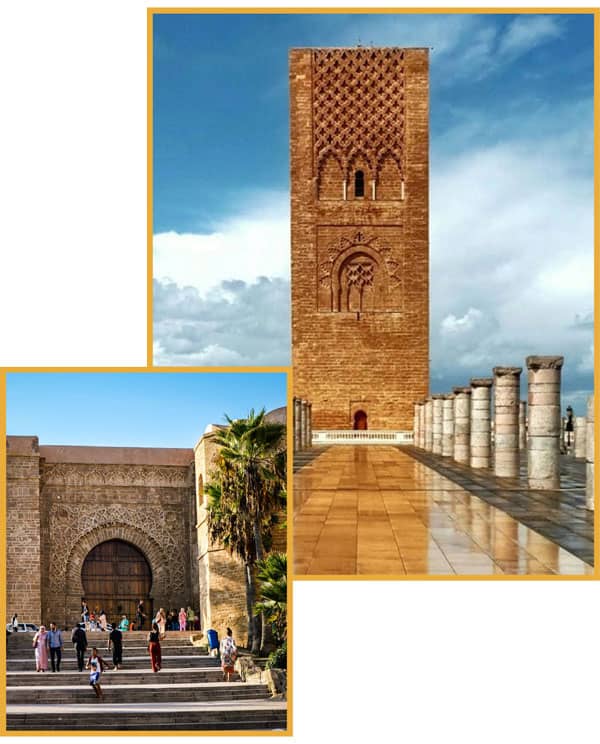
Architectural Marvels: Mosques, Palaces, and Medinas
Morocco’s architecture is a vivid reflection of its multicultural heritage, shaped by Islamic, Berber, Moorish, and Andalusian influences. From the ornate mosques that grace city skylines to the majestic palaces and maze-like medinas that tell tales of sultans and scholars, Morocco’s built environment is as culturally rich as it is visually stunning.
Mosques: Spiritual and Architectural Landmarks
Moroccan mosques are not just places of worship—they are masterpieces of design and craftsmanship. With intricate geometric patterns, arabesque carvings, and towering minarets, these sacred spaces embody the aesthetic ideals of Islamic architecture.
One of the most iconic is the Koutoubia Mosque in Marrakech. Dating back to the 12th century, it stands as a prime example of Almohad architecture with its 77-meter-high minaret, which served as a model for others in Seville and Rabat. Though non-Muslims cannot enter the mosque itself, the surrounding gardens and the mosque’s majestic exterior offer plenty to admire.
In Casablanca, the Hassan II Mosque redefines grandeur. Completed in 1993, it is the largest mosque in Africa and features the world’s tallest minaret at 210 meters. Perched on the Atlantic coast with part of its floor made of glass, it offers worshippers a view of the ocean below—a symbolic connection between earth and sea. Unlike most Moroccan mosques, the Hassan II Mosque is open to non-Muslim visitors, making it a must-see for any cultural traveler.
In Fes, the Al Quaraouiyine Mosque forms part of the ancient university complex and is considered one of the oldest in the Muslim world. Its understated beauty lies in its harmonious proportions, peaceful courtyards, and scholarly atmosphere that echoes centuries of religious devotion and learning.
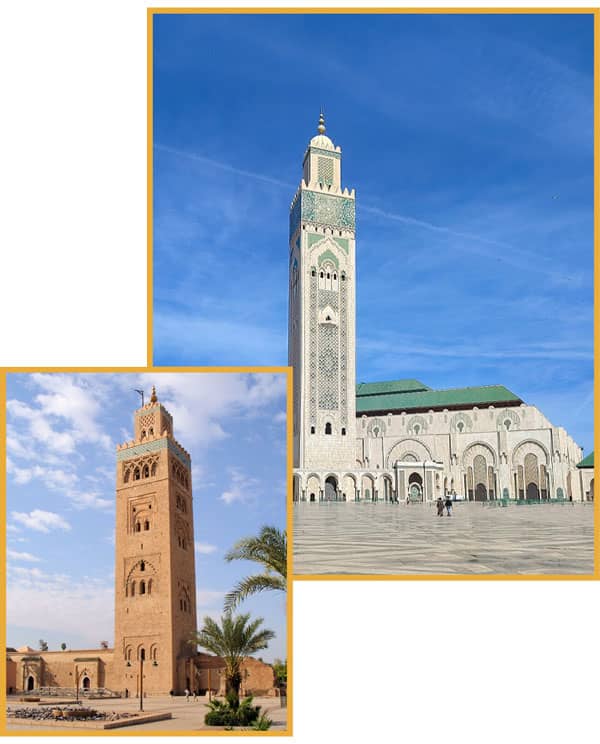
Palaces: Regal Residences and Cultural Testaments
Morocco’s palaces provide a window into the lives of sultans, viziers, and high-ranking officials, reflecting both luxury and tradition. They are typically built around serene courtyards adorned with fountains, zellij tile mosaics, and carved cedar ceilings.
The Bahia Palace in Marrakech is a highlight of 19th-century Moroccan design, intended to be the most magnificent palace of its time. Spanning eight hectares, it features tranquil gardens, lavish harem quarters, and richly decorated salons, offering insight into the opulence of Morocco’s elite under the Alaouite dynasty.
In Rabat, the Royal Palace (Dar al-Makhzen) is the current residence of the King of Morocco. Though not open to the public, visitors can admire its elaborate gates, grand entrance plaza, and surrounding gardens, all reflecting traditional Moroccan architectural elements mixed with modern state functions.
Fes also houses the Dar Batha Palace, a former royal residence turned museum that showcases a wide collection of Moroccan arts, including ceramics, textiles, and carved wood. The palace itself is an artistic treasure, with horseshoe arches and blue zellij tiles creating a serene and elegant setting for the cultural exhibits.
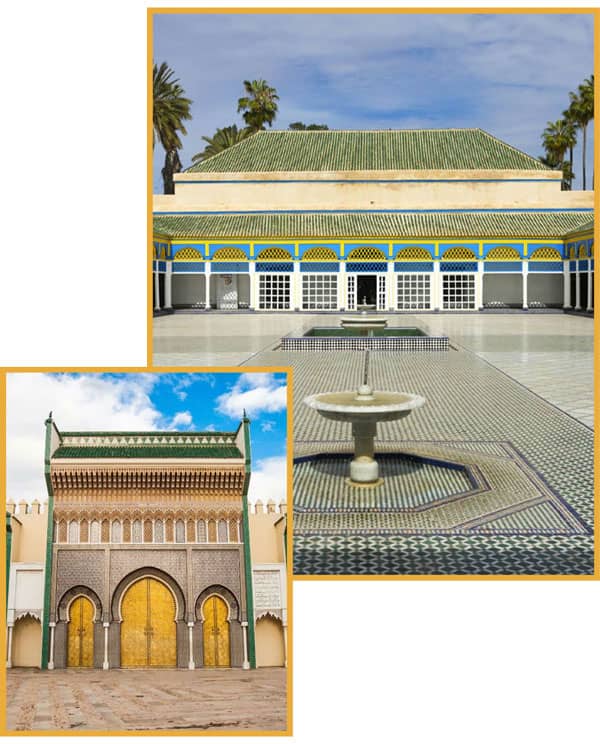
Step Into the Soul of Morocco via a Cultural Tour
Join our immersive Moroccan Cultural Tour and experience the rich history, vibrant traditions, and timeless craftsmanship of this captivating country. Wander ancient medinas, sip mint tea with locals, marvel at architectural wonders, and witness living heritage in every step.
Medinas: The Heart of Moroccan Urban Life
The medina is the soul of any Moroccan city. Enclosed by ancient walls, these old quarters are a sensory explosion—narrow alleyways brimming with colorful shops, aromatic food stalls, and the call to prayer echoing from nearby mosques. Each medina is unique, shaped by its history and geography, yet all share the characteristics of dense urban planning, traditional architecture, and community-oriented living.
Fes el-Bali is arguably the most famous medina in Morocco. This UNESCO World Heritage Site feels like a living maze, with no cars, just donkeys and handcarts navigating the tight lanes. Within its walls, you’ll find historic madrasas, centuries-old tanneries, and endless souks offering everything from spices to silver.
Marrakech’s medina is more vibrant and commercial, with a mix of tourist-friendly shops and authentic artisan workshops. The rhythm here is faster, the colors bolder, and the experience more theatrical—especially around Jemaa el-Fnaa. It’s a place where tradition and tourism collide in fascinating ways.
Meknes’ medina offers a calmer, more introspective experience. Smaller in scale and less crowded, it invites leisurely exploration. You can browse local markets, sip mint tea in quiet courtyards, and interact with artisans in a more personal setting. Its slower pace makes it ideal for cultural travelers looking for depth over spectacle.
Whether you’re standing before the grand façade of a mosque, wandering through palace corridors, or losing yourself in the winding paths of a medina, Morocco’s architectural wonders immerse you in the country’s soul. Each structure, gate, and street is a living testimony to Morocco’s layered past and enduring artistic legacy.
Local Traditions and Festivals in Morocco
Moroccan culture is not only preserved in architecture and monuments but also vibrantly expressed through its living traditions and festivals. These events provide a deeper understanding of the country’s spiritual roots, tribal customs, agricultural rhythms, and artistic expressions. Attending or even just observing one of Morocco’s many festivals or traditional ceremonies offers travelers an unforgettable experience into the very heartbeat of Moroccan life.
Traditional Customs Rooted in Daily Life
Moroccan traditions are woven into daily interactions, family life, and communal gatherings. Hospitality, for example, is a deeply ingrained cultural value. Guests are often welcomed with mint tea, a national symbol of friendship and generosity. The tea is traditionally served three times, each with its own symbolic meaning, and poured from a height to create foam—a sign of respect and proper etiquette.
Another key custom is hammam culture—the traditional Moroccan bathhouse. These steamy public baths are not just for cleansing but also serve as social spaces, especially for women. Visiting a hammam is a way to engage with a centuries-old tradition of self-care and community bonding.
Dress and etiquette are also important aspects of Moroccan tradition. In more conservative areas, traditional clothing like the djellaba (a long, hooded robe) is commonly worn. These garments are often beautifully embroidered and vary by region, gender, and occasion. During religious celebrations or weddings, attire becomes especially elaborate, showcasing Morocco’s rich textile heritage.
Religious Festivals: Spirituality in Celebration
As an Islamic country, many of Morocco’s most significant festivals follow the Islamic lunar calendar and revolve around religious observance. Ramadan, the holy month of fasting, is a time of spiritual reflection, charity, and community. While many businesses shorten their hours during this month, evenings come alive with the breaking of the fast, known as Iftar, where families gather to enjoy harira soup, dates, and sweet pastries.
The end of Ramadan is marked by Eid al-Fitr, a joyful celebration filled with feasting, new clothes, and family visits. Another major religious holiday is Eid al-Adha, or the “Festival of Sacrifice,” which commemorates the willingness of Ibrahim (Abraham) to sacrifice his son in obedience to God. During this time, families traditionally slaughter a sheep and share the meat with neighbors and the less fortunate.
Non-Muslim travelers are welcomed with kindness during these religious festivals and can witness the strong sense of community and spirituality that defines Moroccan society. However, it’s recommended to dress modestly and be respectful of fasting customs during daylight hours in Ramadan.
Cultural Festivals: Music, Arts, and Amazigh Heritage
Beyond religious observance, Morocco celebrates its diversity with a wide range of secular and cultural festivals. These events highlight everything from traditional music and dance to contemporary cinema and global art movements.
One of the most famous is the Fes Festival of World Sacred Music, which draws performers and audiences from across the globe. Held annually in the spiritual capital of Fes, the festival features mystical Sufi chants, Andalusian orchestras, and spiritual performances from all faiths and cultures—celebrating unity through music.
In the south, the Moussem of Tan-Tan is a UNESCO-recognized festival of nomadic tribes that showcases Amazigh (Berber) culture. Tribal groups from the Sahara come together in colorful tents to share traditional dances, camel races, storytelling, and artisanal crafts. It is a cultural spectacle that brings the ancient lifestyle of desert tribes into the spotlight.
Marrakech’s International Film Festival is another major event that has put Morocco on the global cinema map. Featuring international premieres, workshops, and red carpet appearances, this festival brings together Hollywood stars and Moroccan filmmakers in an inspiring cultural dialogue.
In the Atlas Mountains and remote villages, seasonal festivals mark agricultural cycles, such as the Rose Festival in El Kelaa M’Gouna, where entire communities celebrate the annual rose harvest with parades, rosewater distillation, and the crowning of a Rose Queen. Similarly, the Date Festival in Erfoud honors the region’s most important crop with music, exhibitions, and a lively market atmosphere.
Wedding Traditions and Family Celebrations
A Moroccan wedding is one of the most elaborate cultural celebrations you can witness. These multi-day events combine spiritual rituals with luxurious feasting, traditional music, and an incredible display of traditional dress and henna art. The henna night, where the bride’s hands and feet are decorated with intricate patterns, is especially meaningful, symbolizing protection, beauty, and good fortune.
Every region of Morocco has its own wedding customs, with variations in songs, dances, and even culinary traditions. In Amazigh villages, for instance, traditional instruments like the bendir (frame drum) and ghaita (reed flute) accompany tribal dances that can last for hours.
Whether it’s a national festival or an intimate family celebration, Moroccan traditions offer travelers countless opportunities to engage with a culture that is both deeply rooted and joyfully expressive.
Guide to Cultural Holidays in Morocco / Moroccan official Public holidays:
January 1 – New Year’s Day
New Year’s Day is a secular public holiday celebrated across Morocco, marking the beginning of the Gregorian calendar year. While it doesn’t have deep cultural roots in Moroccan traditions, it’s widely recognized in business, education, and public administration, with government offices and many businesses closed for the day.
January 11 – Proclamation of Independence Day
This day commemorates the historic moment in 1944 when Moroccan nationalists submitted the Proclamation of Independence to French authorities, demanding an end to colonial rule. Though Morocco didn’t achieve full independence until 1956, January 11 marks the formal start of its independence movement.
January 14 – Amazigh New Year (Yennayer)
Also known as Yennayer, this holiday celebrates the Amazigh (Berber) New Year. It’s rooted in ancient agrarian traditions and coincides with the Julian calendar’s beginning. Recognized officially in recent years, it symbolizes Morocco’s commitment to preserving Amazigh heritage and identity through traditional food, dance, and cultural events.
May 1 – Labour Day
International Workers’ Day, or Labour Day, honors the social and economic achievements of workers. In Morocco, it’s a national public holiday marked by peaceful demonstrations, union gatherings, and political speeches emphasizing workers’ rights and welfare.
July 30 – Throne Day
Throne Day celebrates the accession of King Mohammed VI to the throne in 1999. It is one of Morocco’s most significant national holidays, symbolizing loyalty between the monarchy and the people. The day is marked by royal addresses, official ceremonies, and patriotic events nationwide.
August 14 – Oued Ed-Dahab Day
This day celebrates the reintegration of the Oued Ed-Dahab (Rio de Oro) region into Moroccan territory in 1979, following its peaceful recovery from Spanish control. It’s a symbol of national unity and Morocco’s sovereignty over its southern provinces.
August 20 – Revolution of the King and the People
Commemorating the 1953 exile of Sultan Mohammed V by French colonial powers and the subsequent popular uprising, this holiday reflects the deep bond between the Moroccan monarchy and its people. The day highlights the nation’s struggle and unity against colonial rule.
August 21 – Youth Day (King Mohammed VI’s Birthday)
Youth Day coincides with the birthday of King Mohammed VI. It celebrates the role of youth in shaping the future of Morocco and is marked by public events, concerts, and initiatives promoting education, innovation, and civic engagement among young people.
November 6 – Green March Day
The Green March marks the peaceful 1975 demonstration in which over 350,000 Moroccans marched into Western Sahara to assert Moroccan sovereignty over the region after Spanish withdrawal. It is remembered as a powerful example of peaceful protest and national solidarity.
November 18 – Independence Day
Morocco’s official Independence Day celebrates the end of French and Spanish colonial rule in 1956. This national holiday honors King Mohammed V’s return from exile and the restoration of the Moroccan monarchy’s sovereignty. It is celebrated with patriotic fervor, speeches, parades, and cultural displays.
Islamic Holidays (Based on the Hijri Calendar)
Eid al-Fitr
Eid al-Fitr, or the Festival of Breaking the Fast, marks the end of Ramadan, the holy month of fasting in Islam. The celebration begins with special morning prayers and continues with feasting, charity (Zakat al-Fitr), and visits to family and friends. Moroccan families often prepare traditional sweets like chebakia and dress in new clothes for the occasion.
Eid al-Adha
Also known as the Feast of Sacrifice, Eid al-Adha commemorates Prophet Ibrahim’s (Abraham’s) willingness to sacrifice his son as an act of obedience to God. Moroccan Muslims observe the day by performing the ritual sacrifice of a sheep or goat and distributing the meat among family, neighbors, and the needy. It’s the most significant religious holiday in the Islamic calendar.
Islamic New Year – June 27
The Islamic New Year, also called Hijri New Year, marks the migration of the Prophet Muhammad from Mecca to Medina. While not widely celebrated with festivities in Morocco, it is a moment of reflection and spiritual renewal for many Muslims.
Mawlid al-Nabawi
This holiday commemorates the birth of the Prophet Muhammad (peace be upon him). In Morocco, the celebration varies by region but often includes religious sermons, Qur’an recitations, and gatherings in mosques or homes. Sufi brotherhoods may also hold night-time processions with chanting and prayer, and traditional dishes are often served to mark the occasion.
Pottery: A Colorful Legacy
Moroccan pottery is one of the oldest and most iconic forms of traditional craftsmanship, with roots tracing back to the Berber and Andalusian cultures. The cities of Fes and Safrou are particularly famous for their zellij tiles—intricate geometric mosaics crafted from hand-cut ceramic pieces. These are used to decorate fountains, walls, courtyards, and mosques across the country.
Safi, located on Morocco’s Atlantic coast, is the pottery capital of the country. Here, you can visit local workshops to see artisans shaping and firing clay in age-old kilns. Safi pottery is often characterized by bold cobalt blues and floral motifs, while Tamegroute, a village in the Draa Valley, is known for its unique green-glazed ceramics made with ancient mineral recipes.
These pottery pieces are not only beautiful but also utilitarian, used for serving dishes like tagine or couscous. Owning a piece of Moroccan pottery is like holding a fragment of the country’s artistic DNA.
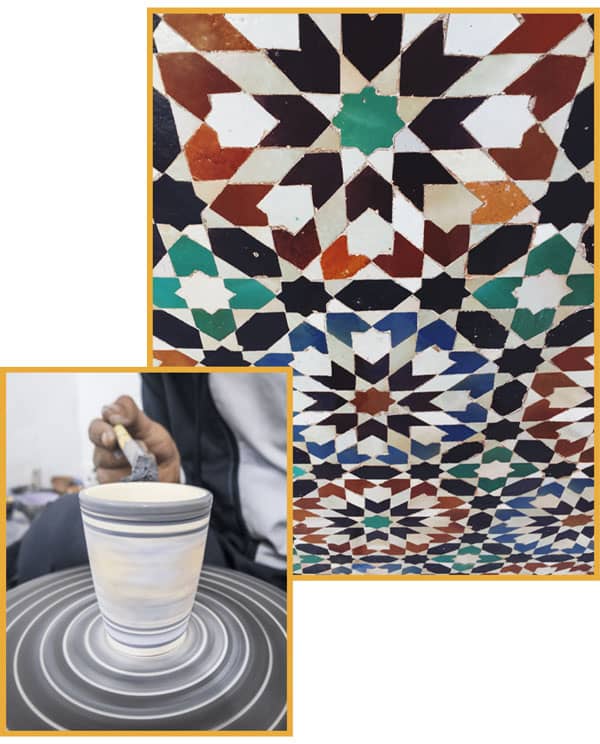
Leatherwork: The Ancient Tanneries of Morocco
Moroccan leather is world-renowned for its quality and craftsmanship, and nowhere is this more visible than in the ancient tanneries of Fes and Marrakech. The Chouara Tannery in Fes, in operation since the 11th century, is a sensory experience unlike any other—pits of natural dyes in vivid reds, yellows, and blues are laid out like a painter’s palette, with craftsmen knee-deep in the process of softening and coloring hides.
Traditional tanning techniques use natural substances like pigeon droppings, lime, and henna, a method that has remained unchanged for centuries. Once processed, the leather is used to make slippers (babouches), handbags, jackets, poufs, and notebooks. Each item is handcrafted with extraordinary attention to detail, and buying leather goods in Morocco often involves direct interaction with the maker, a rare experience in today’s mass-produced world.
For a more immersive experience, you can take a guided tour of a tannery and even learn how to identify genuine Moroccan leather by its rich texture and earthy scent.
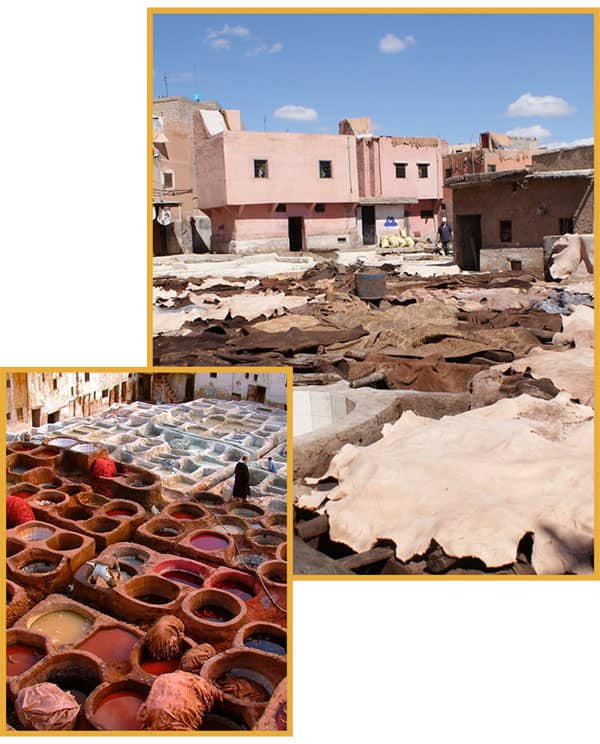
Carpets: Woven Symbols of Identity
Moroccan carpets are not just floor coverings—they’re woven expressions of identity, memory, and emotion. The art of carpet weaving is primarily practiced by Amazigh (Berber) women in the Atlas Mountains and rural villages, where each tribe has its own distinctive style, motifs, and color palettes.
For example, Beni Ourain rugs from the Middle Atlas are characterized by their minimalist ivory backgrounds and black geometric patterns, highly sought-after in contemporary design circles. On the other hand, Azilal rugs use bolder colors and abstract motifs, often incorporating personal or spiritual symbols that make each piece unique.
The process of weaving is intensely laborious. It can take weeks or even months to complete a single rug, depending on its size and complexity. Wool is washed, dyed using natural pigments, and hand-knotted on vertical looms, a practice that has changed little over time. Many weavers do not follow a drawn pattern; instead, they work from memory or emotion, giving each carpet a story and soul.
Visiting a weaving cooperative in a village or medina is one of the best ways to appreciate this craft. Not only can you witness the creation process firsthand, but you also support local artisans directly, helping preserve this ancient art form for future generations.
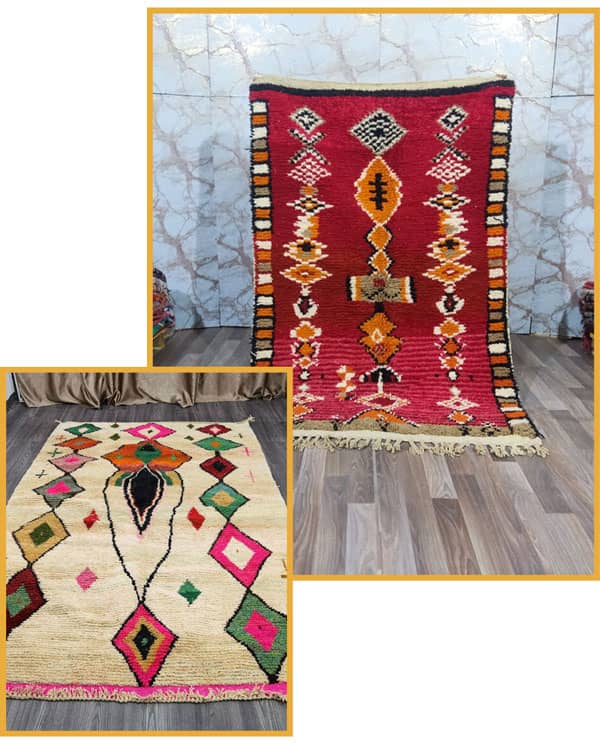
Beyond Souvenirs: A Living Cultural Economy
What makes Moroccan craftsmanship so special is that it remains a living tradition. These are not museum pieces, but everyday objects infused with artistic value—plates that serve food at family gatherings, rugs that warm the floors of mountain homes, slippers worn during religious festivals.
Whether you’re browsing the vibrant souks of Marrakech, touring the artisan districts in Fes, or visiting small mountain villages, you’ll find yourself surrounded by creativity. Craftsmanship in Morocco isn’t just about aesthetics—it’s about community, resilience, and continuity. It’s a tangible connection to Morocco’s deep-rooted cultural fabric.
Suggested Itinerary for Cultural Travelers in Morocco (7 Days)
Day 1: Arrival in Fes – The Spiritual Heart
-
Explore Fes el-Bali medina
-
Visit Al Quaraouiyine University and Bou Inania Madrasa
-
Observe traditional tanneries at Chouara
-
Overnight in a riad
Day 2: Fes to Meknes (Day Trip)
-
Drive to Meknes (approx. 1 hr)
-
Explore Bab Mansour, Heri es-Souani granaries, and El Hedim Square
-
Optional stop at Volubilis Roman ruins en route back
-
Return to Fes for the night
Day 3: Fes to Marrakech via Casablanca (Train or Private Transfer)
-
Optional brief stop at Hassan II Mosque in Casablanca
-
Arrive in Marrakech and check into a traditional riad
-
Evening stroll in Jemaa el-Fnaa Square
Day 4: Marrakech Cultural Sites
-
Bahia Palace and Saadian Tombs
-
Visit the Koutoubia Mosque
-
Relax in a traditional hammam
-
Attend a cultural performance or dinner with live music
Day 5: Craftsmanship and Souks
-
Explore Marrakech’s souks: carpets, leather, spices, and lanterns
-
Visit artisan workshops in the Mellah or Souk Semmarine
-
Optional visit to Ensemble Artisanal for authentic handicrafts
-
Learn about zellij tilework and Moroccan design
Day 6: Day Trip to Ourika Valley or Ait Ben Haddou
-
Visit Amazigh villages and local markets
-
Learn about rural traditions and hospitality
-
Optional: Explore Ait Ben Haddou for historical architecture
Day 7: Departure
-
Morning free for final shopping or tea in a courtyard café
-
Transfer to Marrakech or Casablanca airport
Tips for Respectful Cultural Tourism in Morocco
1. Dress Modestly
Wear clothing that covers shoulders, chest, and knees—especially in rural areas and religious sites. Loose, breathable clothes also help with the heat.
2. Learn Basic Arabic or French Phrases
Even a simple “Salam Alaikum” (peace be upon you) or “Shukran” (thank you) is appreciated and shows respect.
3. Ask Before Taking Photos
Especially of people, religious sites, or artisans. It’s polite to ask permission, and some may decline.
4. Support Local Artisans and Cooperatives
Buy directly from local weavers, potters, and tanners when possible. It ensures fair income and keeps traditions alive.
5. Respect Religious Practices
Avoid eating, drinking, or smoking in public during Ramadan. When visiting mosques (if permitted), remove your shoes and dress appropriately.
6. Be Mindful During Festivals
Some festivals are sacred and involve rituals. Observe quietly and ask questions respectfully if you’re unsure.
7. Use a Licensed Local Guide
A knowledgeable guide can enrich your experience and help bridge cultural gaps respectfully and accurately.
8. Avoid Bargaining Aggressively
Haggling is expected in souks, but keep it friendly. Remember, small purchases can mean a lot to local sellers.
Final Thoughts
A cultural holiday in Morocco is far more than sightseeing, it’s an immersion into a way of life shaped by centuries of history, creativity, and spiritual depth. Whether you’re walking the ancient streets of Fes, marveling at Marrakech’s mosaics, celebrating local festivals, or shopping for handcrafted treasures, every experience enriches your understanding of what makes this country so captivating.
Morocco doesn’t just preserve its culture, it lives it every day. And for the culturally curious traveler, that is the real treasure.

